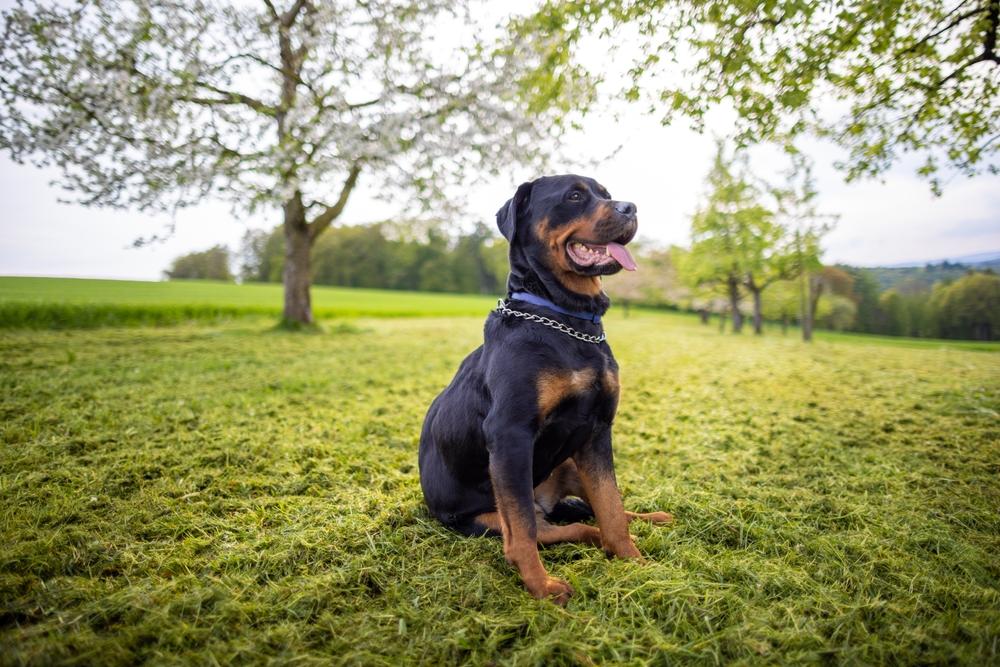While every country has its most popular breeds, perhaps no dog is more universally beloved than the Rottweiler. Affection, devotion, and a square balance of confident calmness and protective instinct define this rugged worker, a descendant of ancient Roman Molossian drover dogs. Yet, the exact description of the typical Rottweiler may vary depending on where you are.
As the Rottweiler expanded beyond their native Germany, differences in breeding philosophies have led to commonly perceived distinctions between Rottweilers across the globe. Let’s explore four types of Rottweiler breeds and how you can tell them apart.

How Are Rottweiler Dog Breeds Classified?
Differing breeding philosophies have led many to observe general distinctions between Rottweilers based on where they originated. Whether genuine differences between Rottweiler varieties exist is a matter of debate, but many feel American, German, and other regional breeds are distinct enough to affect the ownership experience.
Regardless, all Rottweilers are part of the same breed, and you can expect more similarities than differences. Rottweilers are powerful medium–large dogs with heavy-boned, muscular builds covered in short black coats featuring rust-colored markings.
Well-bred Rottweilers are good-natured, loyal, and trainable. They have a powerful motivation to please and protect their family and are intelligent and thoughtful. Though they remain aloof around others, they are confident and brave, always maintaining alert yet controlled and level manners.

The 4 Types of Rottweiler Dog Breeds
1. German Rottweilers

With 98 members and contract partners, each representing a different country, the Federation Cynologique Internationale is the largest kennel club globally. The FCI works with affiliated breed clubs or registries from each breed’s founding country (i.e., where the breed originated) to formulate a standard it disseminates to its members.
In the Rottweiler’s case, the founding country is Germany. As its national Rottweiler club, the Allgemeiner Deutscher Rottweiler-Klub e.V. (ADRK) is the prevailing authority on the breed, setting the standard for what we might consider a “German” Rottweiler.
The ADRK sets rigid physical and behavioral criteria for its dogs. It defines the breed standard and considers companion suitability and temperament in breeding programs to refine the ideal dog. German Rottweilers are excellent workers and companions, and they’re ever-protective and obedient for a competent owner.
Temperament
Temperament is of paramount importance for German Rottweiler breeders. The ADRK requires testing before registered dogs can enter breeding programs, distinguishing them from dogs under more relaxed American standards.
Alongside a companion dog test, hip and elbow exams, and other prerequisites, breeding dogs must pass the ZTP (Zuchttauglichkeitsprüfung) breed suitability test. The test looks at several crucial Rottweiler qualities, including:
- Physical conformation
- Reactions to gunshots
- Bitework (protecting the handler)
- Stability around others
The Körung is a higher-level breeding test with stricter rules. Dogs must be older and pass the ZTP before advancing to this stage. They must also meet the criteria for endurance and working titles and show results to achieve the preferred breeding status.
Physical Distinctions
Anecdotal evidence suggests that German Rottweilers are distinct in some physical characteristics. Many say they have blockier heads and bulkier, more imposing frames. They’re robust dogs with sturdy bodies to back their confident nature.
Despite the oft-discussed differences, the breed standards between American and German Rottweilers are similar and share much of the same language. Indeed, many American Rottweilers have what some might call a German look. It all depends on the quality of the breeding.
A notable difference between the breed standards involves the tail. While the AKC standard allows docking, German Rottweilers must be unmodified. Ideally, their tails should be long enough to reach the hocks when they lie along the leg.
2. American Rottweilers

Technically, American Rottweilers are any Rottweilers born in America, though there are multiple schools of breeding thought even within the United States. On one side is the AKC, its standard, and its collection of breeders. The other consists of breeders abiding by the ADRK process.
The AKC’s Rottweiler standard doesn’t differ much from the ADRK’s, so American and German Rottweilers can look virtually identical. Yet, the stricter breeding requirements on the German side have gradually spurred perceived differences in personalities and physique.
Temperament
The AKC’s definition of the Rottweiler’s temperament is similar to the ADRK. According to the AKC standard, aloofness and an aggressive attitude toward dogs are not fault-worthy. If the dog is shy or menacing towards people, though, the judge will excuse them from the ring.
Otherwise, the AKC doesn’t set any stipulations for registered Rottweiler breeders. Many feel the American dog’s character suffered as a result. Compared to the hardy German working dog, American Rottweilers have a reputation in some circles for being shyer, less confident, and less work-motivated.
Some find they lack the German dog’s attitude, replacing the high prey drive and aggression with a more elegant personality. Of course, these distinctions are primarily subjective and don’t recognize the consistency between German and American standards.
While more lenient breeding rules may allow for a milder temperament in American-bred dogs, responsible Rottweiler breeders commit to a similar character and form, regardless of where the dogs hail from.
Physical Distinctions
Apart from the tail-docking measure, the AKC standard notably differs from the ADRK in one area: the belly tuck. While the AKC calls for a slight tuck-up, the German standard notes that the flank should not have a tuck.
Minor differences aside, not much separates the physical standards for American and German Rottweilers. Yet, as with the temperament, many find the American Rottweiler’s frame is slightly more refined.
Unlike the broad-headed German variety, some describe American Rottweilers as having shorter, slimmer, and all-around lighter bodies. They seem rangier, with finer bone structures, tinier heads, and narrow snouts. The smoother, graceful form seemingly reduces the Rottweiler’s original rugged and imposing stature.
Again, dogs can’t stray too far from the norm, or they’ll no longer meet any Rottweiler standard. Rottweilers are still Rottweilers. Despite the prejudice, many German dogs can look “American,” and American Rottweilers can have a “German” appearance if they have the tail intact. It all depends on the breeder’s preferences.
3. Roman Rottweilers

Roman Rottweilers are an apparent throwback to the centuries-old Roman drover dogs from which the modern Rottweiler descends. Two thousand years ago, ancient Roman legions used their fearsome Molossian dogs to drive and protect livestock as they spread their influence, and their stop in Rottweil, Germany, became the home of the original Rottweiler offshoot.
Physical Distinctions
The Roman Rottweiler is the largest of any Rottweiler and has a more Mastiff-like appearance. To achieve this look, breeders add Tibetan Mastiff and other large-breed genetics to the standard Rottweiler.
The Roman Rottweiler head is bulkier, their bodies heavier, and their legs are much longer. They can stand several inches taller than other Rottweiler breeds. Being larger dogs, these Rottweilers are also more susceptible to heart and orthopedic issues.
Is the Roman Rottweiler a Real Rottweiler Breed?
The Roman Rottweiler term is generally considered a marketing gimmick for breeders developing giant versions of the classic German dog. The name itself is somewhat inaccurate.
Rottweilers were not Roman but emerged when ancient Molossus dogs crossed with local breeds in Rottweil. For modern breeders, the “Roman” label doesn’t speak to the dog’s ancestry. It simply means the dogs are larger.
4. Serbian Rottweilers

As a newer Rottweiler variety, the Serbian Rottweiler was first popularized in Eastern European countries and has become adored across the globe. What sets the Serbians apart? It’s their size, and they’re mostly known for larger bodies and blockier heads.
More glaring than anything is the short muzzle. Serbian Rottweilers tend to have more brachycephalic snouts, which gives them a unique look desirable to some owners.
Physical Distinctions
The brachycephalic look is controversial for purists. Any short-snouted breed generally raises animal welfare issues. Brachycephaly can cause various respiratory issues that affect a dog’s quality of life. In recent years, some countries have even restricted the breeding of certain flat-faced varieties to encourage healthier dogs.
Beyond the welfare considerations, the shorter snouts go against the breed standard. According to the AKRC standard, “any muzzle shorter than 40% of the length of the head is too short”. Although they don’t fault the shorter muzzle like the AKRC, the AKC uses similar verbiage.
By its standard, the ideal back skull-to-muzzle ratio is 3:2. This points to a series of ethical concerns. In many instances, the Serbian’s snout, among other minor quirks, is too short to make them a decent show dog.
The desirable look is the focus. Unscrupulous breeders don’t regard the standard as much as their wallets, which results in unsound breeding practices ranging from excessive inbreeding to unreliable health testing.

In Conclusion
The differences between Rottweiler breeds may be real or a matter of opinion, but there’s no denying the interest surrounding the topic. For hopeful owners, it highlights the importance of pedigree and points to cultural considerations that can help you find the best dog for your family.
There aren’t any significant differences between Rottweilers if they’re bred responsibly. The only distinction is where they’re born. With the diversity in breeding approaches, you can likely find your desired Rottweiler variety, whether “American,” “German,” or “Roman,” no matter where you live.
Featured Image Credit: Shedara Weinsberg, Shutterstock



















